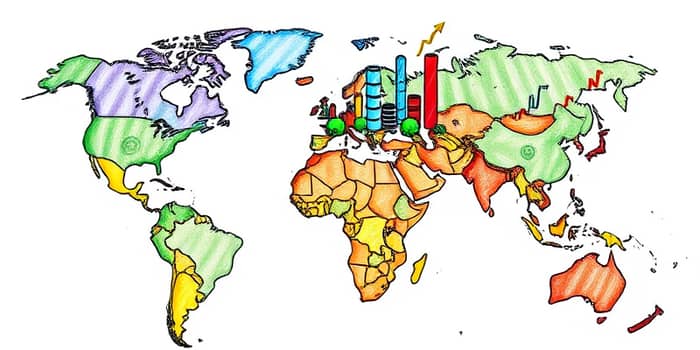In today’s interconnected economy, investors face mounting challenges at home—high valuations, policy uncertainty, and record government debt. Turning attention abroad can unlock opportunities and mitigate risks that domestic markets alone may not address. By embracing a truly global perspective, portfolios gain both resilience and growth potential.
Why Global Investing Matters Now
The U.S. holds a staggering $36.85 trillion in foreign financial assets but owes $61.47 trillion in liabilities, resulting in a negative international investment position of –$24.61 trillion. Meanwhile, shifting leadership in global equities and persistent volatility driven by inflation and geopolitics underscore the need for diversification beyond domestic borders.
Emerging markets and international stocks have outperformed U.S. equities in 2025. This trend reflects both relative valuations and stronger growth forecasts abroad. With U.S. GDP expected to grow at 2.0% versus 4.2% in China and 0.9% in the Eurozone, investors must weigh global dynamics rather than relying solely on American strength.
Recent Global Performance Snapshot
Equity markets from Mexico to Korea have delivered eye-catching returns in the first quarter of 2025. Currency dynamics have further amplified these gains in U.S. dollar terms, making international allocations even more compelling as the greenback shows signs of weakness against key currencies.
- Mexico & Brazil up ~30% year-to-date driven by stronger commodity prices and domestic reforms.
- China’s equities up 25%, fueled by technology giants like Tencent and Alibaba.
- Korea leads with 43% gains; South Africa benefits from a rally in gold and mining stocks.
- Europe outperforms as falling rates and robust corporate earnings boost financials and industrials.
Macro Forces Shaping Markets
Persistent inflation and policy uncertainty have challenged central banks’ ability to cut rates, injecting volatility into global markets. As monetary authorities calibrate tightening cycles, capital seeks higher returns in regions with more accommodating stances and lower valuations.
Geopolitical tensions, evolving trade policies, and protectionist measures are reshaping supply chains and spurring investment rotations. Countries with national industrial strategies or lower exposure to tariff disputes are emerging as alternative hubs for manufacturing, technology, and resource extraction.
Key Regional Opportunities
Investors scanning the globe can identify pockets of rapid growth and compelling valuations. Developed markets like Europe offer value in banks and industrials as policy eases. In contrast, emerging economies deliver higher GDP growth and attractive entry points.
- Europe: Banks, defense, and industrial sectors stand to benefit from looser monetary policy and resilient corporate earnings.
- Asia: India and Indonesia exhibit high-growth trajectories, while Japan and Korea combine innovation with shareholder-friendly reforms.
- Latin America: Mexico and Brazil capitalize on commodity tailwinds and domestic policy improvements.
- Africa: South Africa’s mining sector and selective frontier markets offer diversification away from mainstream risk.
Building a Resilient Portfolio
Diversification remains the cornerstone of risk mitigation. Allocating across regions, sectors, and asset classes can protect investors against local downturns and unforeseen shocks. Alternatives provide additional ballast when public markets falter.
- Diversification across regions and asset classes helps guard against geopolitical shocks.
- Inflation-linked bonds, real estate, and commodities offer inflation protection and yield enhancement.
- Private markets—private equity, private credit, and real assets—deliver longer-term capital growth and diversification benefits.
- Broadening into smaller markets and niche sectors uncovers undervalued opportunities beyond major indices.
Constructing a global portfolio also entails dynamic rebalancing to capture rotating themes. As inflation persists and sector leadership shifts, value exposures in energy and materials may outperform traditional growth names.
Forward-Looking Themes and Structural Trends
Looking ahead, investors must adapt to a fragmented world with evolving alliances. The era of unfettered globalization is giving way to regional blocs and supply chain diversification. This realignment will influence where capital flows and which industries prosper.
Technology and artificial intelligence continue to reshape productivity globally. Firms leveraging AI-driven efficiencies can drive outsized returns across public and private markets. Meanwhile, sustainability considerations and ESG frameworks are increasingly integrated into institutional investment strategies, influencing capital allocation decisions.
“Post-globalization” investment models prioritize resilience over absolute efficiency. Companies and economies that can navigate shifting trade flows, maintain diversified supplier networks, and adhere to evolving regulatory standards will appeal to forward-thinking investors.
Risk Considerations in Global Markets
No strategy is immune to pitfalls. Political upheaval, regulatory shifts, and election-driven volatility can upend markets overnight. Currency movements—both appreciation and depreciation—compound returns or losses in dollar-denominated portfolios.
Investors must also assess liquidity constraints, particularly in private markets and frontier regions. While these segments offer attractive long-term prospects, limited secondary markets and extended lock-up periods demand careful planning and risk tolerance.
Finally, legacy risks linger in all regions: stretched valuations in parts of Europe, slower growth in China, and fiscal pressures in emerging economies. A judicious mix of research, active management, and disciplined rebalancing can help navigate these uncertainties.
Conclusion: Embracing a Global Mindset
Global investing is not merely a tactical play; it represents a strategic shift toward embracing the full spectrum of opportunities and risks that our interconnected world presents. By diversifying across borders, asset classes, and economic regimes, investors can enhance returns, reduce portfolio volatility, and position themselves for the next wave of global growth.
In 2025 and beyond, the most successful portfolios will reflect a thoughtful blend of public and private assets, developed and emerging markets, and traditional holdings balanced with innovative themes. Expanding your horizon beyond borders is not just prudent—it is essential for achieving sustainable, long-term investment success.
References
- https://www.bea.gov/news/2025/us-international-investment-position-1st-quarter-2025-and-annual-update
- https://www.troweprice.com/financial-intermediary/se/en/lp/global-market-outlook.html
- https://www.morningstar.com/markets/why-2025-is-year-invest-international-stocks
- https://www.deutschewealth.com/en/insights/investing-insights/economic-and-market-outlook/cio-annual-outlook-2025-deeply-invested-in-growth.html
- https://www.mckinsey.com/industries/private-capital/our-insights/global-private-markets-report
- https://mena.assetmanagement.hsbc.com/en/intermediary/global-investment-outlook-2025
- https://unctad.org/publication/world-investment-report-2025
- https://www.blackrock.com/corporate/insights/blackrock-investment-institute/publications/outlook










